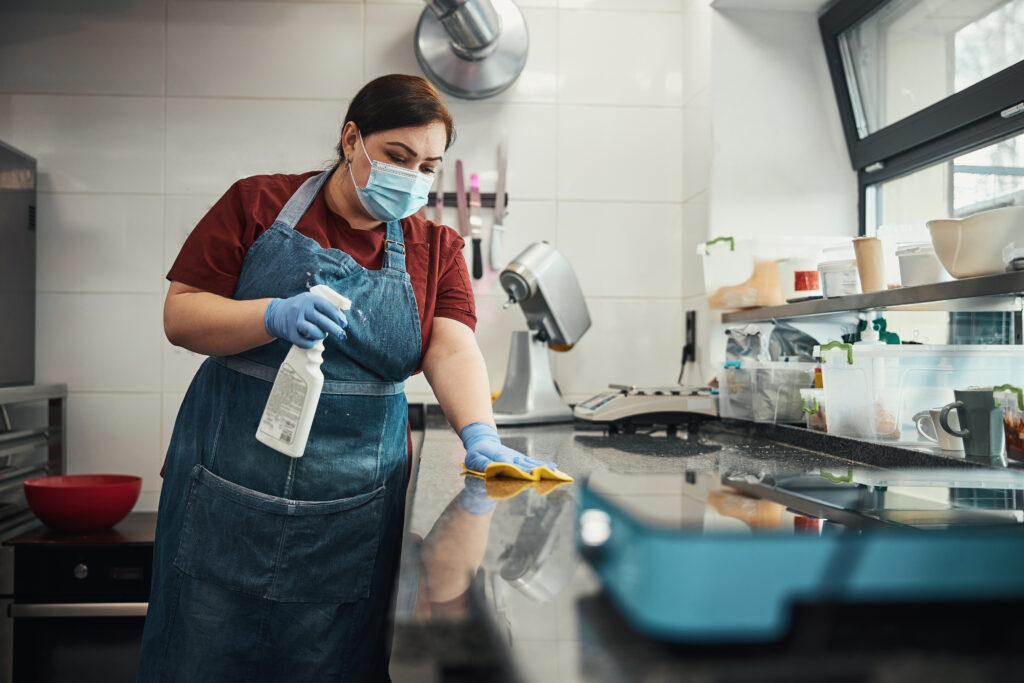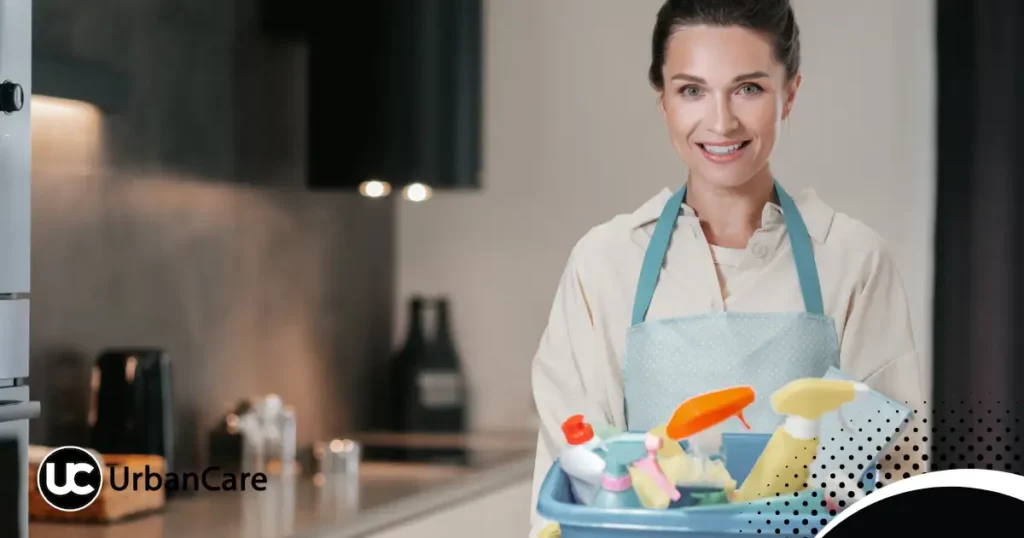Cleaning the kitchen must be done regularly. There is a tendency for food to accumulate on the counters, cookware to accumulate in the sink, and household paperwork to accumulate on the table. In order to facilitate domestic cleaning, we wanted to see if there were ways to speed cleaning the kitchen up.
Here is a simple guide to cleaning the kitchen, including a step-by-step process to make sure domestic cleaning is an efficient routine that leaves you with a neat and hygienic environment. Our experts at Urban Care have also provided advice on how often you should clean certain kitchen items and when to replace certain kitchen essentials.
Several of these steps are common sense, but if you follow this easy guide, you won’t even have to think about them, and could be done in as little as thirty minutes.

Cleaning the kitchen 101
1. Remove anything stray from the counters: stray mail, cookbooks, permission slips.
2. Add a few squirts of dish soap to hot water in the sink. Soak items such as the crisper drawer, dish rack, and microwave turntable.
3. Cleaning the kitchen refrigerator
Throw out anything that has expired from the refrigerator. Soak dirty food storage containers in the sink. Work your way from top to bottom, wiping the shelves down with a rag sprayed with a nontoxic all-purpose cleaner.
4. Using a duster, dust the high zones and knock dirt and debris to the floor, where they can be swept up later. Starting above the sink, use a telescoping duster to clean upper corners, light fixtures, and the tops of cabinets. Be sure to wipe down the top of the refrigerator as well. Once you’re at the sink again, you’re ready to move on and do more domestic cleaning.
5. Make sure the upper cabinets and any other surfaces on the wall are clean, including a mounted microwave. Let the microwave interior sit for two minutes after spraying with an all-purpose cleaner. Wipe the exterior with a damp, soapy cloth. If the countertop is stainless steel, use a cloth moistened with diluted white vinegar rather than soapy water to remove any fingerprints. Wipe off the upper cabinet doors and the pulls, as well as any other items (frames, hangers, vent grates), as you reach the end of the room. If you have a backsplash, wipe it down with a damp, soapy cloth.
6. Let’s go back to the microwave. The two minutes are up. Use a dry cloth to wipe out the solution. It’s okay if crumbs fall to the floor or onto the stove.
7. Cleaning the kitchen stovetop Apply all-purpose cleaner to the stovetop and let sit for a few minutes. Use a powdered scrub to remove stubborn stains.
8. Put the items soaking in the sink in the dishwasher, or wash them by hand. Wait until the sink is full before draining it.
9. Let the crumbs fall to the floor after wiping the stovetop with a clean, dry cloth. Getting them at the end is more efficient. To avoid grease from transferring to another surface, switch out the cloth once you’re done.
10. Cleaning coffeemakers, toasters, mixers, and other small appliances should be done from top to bottom, using a glass cleaner, a multisurface formula (spray the cloth instead of the appliance), or cleaning wipes. After rinsing and drying the drip trays and crumb catchers, dip them in leftover warm, soapy water.
11. Use a cleaner formulated for your surface to scrub your countertops in small, circular motions.
12. Take a cloth dipped in clean, sudsy water and use it to wipe down the fridge doors, the dishwasher console, and the oven. (If the refrigerator doors are stainless steel, use diluted white vinegar). Make sure the handles and edges are clean. To de-grime tight spots, such as the folds of the refrigerator seal, use a soft toothbrush or a cloth-wrapped spatula. Then, use an all-purpose formula or a cloth dipped in a solution of hot, soapy water and white vinegar to clean the sides of the dishwasher door. (This mixture can be used to clean both the stovetop and the countertops, except if the surfaces are marble, granite, or some other porous stone.)
13. Use a damp, soapy cloth to clean the lower cabinets and drawers.
14. Run hot water over the sink and drain. Using a microfiber cloth and a mild abrasive cleanser, buff the basin. Rinse with warm water. Then clean the handles and faucet.
15. Before replacing the bag, clean the interior and exterior of the trash can with a cleaning wipe.

Conclusion
Rejoice, we are finally done with cleaning the kitchen. There are times when domestic cleaning can be tedious, annoying, and even disgusting. However, a clean kitchen is well worth the effort. Keeping your kitchen clean helps prevent pests, keeps your home sanitary, and makes you feel good about your living environment. Relish the results of all your hard work.

